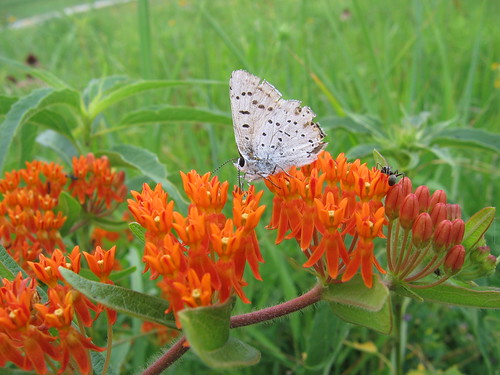
Last week, on a lark, I drove over to the Neal Smith National Wildlife Refuge, a native prairie restoration project on some 5,000 acres in central Iowa. The refuge claims to be is the largest re-creation of tallgrass prairie in the U.S., with more than 200 types of prairie plants
The well-designed learning center has some interesting displays, but the real drama is out on the land. You can take a couple trails through the prairie preserve, and on this day in early July nature stole the show. The prairie flowers were blooming, the birds were singing, and the bees were buzzing.
I spotted at least two birds I’d never seen before, a bobolink and another that looked to be some kind of grouse. I photographed a colorful plant or two, including this spectacular butterfly attractor (photo above).
I had never seen such a rich array of plant species in a prairie restoration and learned later that volunteers have been collecting native seeds from roadsides, cemeteries and railroad beds around the state to plant at the refuge.
Hiking though the prairie there and later driving through the bordering cropland made me think once again how much agriculture has changed the natural world. It seems worth remembering that from time to time.
We have a CRP field of prairie grass on our farm in Nebraska, an excellent stand that includes some native forbs, along with a mix of indiangrass, big bluestem and switchgrass. A walk though the place gives you a little feel for what the country looked like before the plow that broke the plains.
And that wasn’t so long ago. There’s a place down the road where you can still see the remnants of the sod house where my great grandparents lived for a time, and on a hill above there, buffalo wallows from the great herds that once roamed what is now Buffalo County, Nebraska.
The irrigated corn and beans across the road pay the taxes and insurance for the place, but there’s something healthy about being able to take a prairie hike, perhaps to remind one from whence we came.
1 comment:
How does one integrate emotional attachment to an historical piece of ground or traditional landscape with modern demands? How many flowers does one give up to pay for a child's education?
We have buffalo wallows on our farm, too, though they're about farmed out by now. We used to have prairie chickens and jack rabbits, both gone. Instead, we have coyotes where we used to have foxes.
Change is inexorable. It sometimes wrings a pang from our sensibilities.
Post a Comment